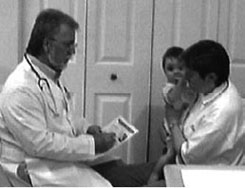Practice Tips: Physician Information Sheet (Pediatrics)
Careful Antibiotic Use
Make promoting appropriate antibiotic use part of your routine clinical practice
![]() Print-friendly version of this academic detailing sheet (48 KB, 1 page)
Print-friendly version of this academic detailing sheet (48 KB, 1 page)
Practice Tips
When parents ask for antibiotics to treat viral infections:
- Explain that unnecessary antibiotics can be harmful.
- Tell parents that based on the latest evidence, unnecessary antibiotics CAN be harmful, by promoting resistant organisms in their child and the community.
- Share the facts.
- Explain that bacterial infections can be cured by antibiotics, but viral infections never are.
- Explain that treating viral infections with antibiotics to prevent bacterial infections does not work.
- Build cooperation and trust.
- Convey a sense of partnership and don’t dismiss the illness as “only a viral infection”.
- Encourage active management of the illness.
- Explicitly plan treatment of symptoms with parents. Describe the expected normal time course of the illness and tell parents to come back if the symptoms persist or worsen.
- Be confident with the recommendation to use alternative treatments.
- Prescribe analgesics and decongestants, if appropriate.
- Emphasize the importance of adequate nutrition and hydration.
- Consider providing “care packages” with nonantibiotic therapies.
- Create an office environment to promote the reduction in antibiotic use.
- Talk about antibiotic use at 4 and 12 month well child visits.

The AAP Guidelines for Health Supervision III
(1997) now include counseling on antibiotic
use as an integral part of well-child care. - Start the educational process in the waiting room.
- Videotapes, posters, and other materials are available.
(http://www.cdc.gov/getsmart/campaign-material/materials.html)
- Videotapes, posters, and other materials are available.
- Involve office personnel in the educational process.
- Reenforcement of provider messages by office staff can be a powerful adjunct to change patient attitudes.
- Use the CDC/AAP pamphlets and principles to support your treatment decisions.
- Provide information to help parents understand when the risks of using antibiotics outweigh the benefits.
![]() This symbol means you are leaving the CDC.gov Web site. For more information, please see CDC's Exit Notification and Disclaimer policy.
This symbol means you are leaving the CDC.gov Web site. For more information, please see CDC's Exit Notification and Disclaimer policy.
File Formats: All viewers, players, and plug-ins used on this site can be downloaded from the file formats page. (For example: Adobe Acrobat Reader for pdf files, Windows Media Player for audio and video files, PowerPoint Viewer for presentation slides, etc.)
Copyrighted images: Images on this website which are copyrighted were used with permission of the copyright holder and are not in the public domain. CDC has licensed these images for use in the materials provided on this website, and the materials in the form presented on this website may be used without seeking further permission. Any other use of copyrighted images requires permission from the copyright holder.
Contact Us:
- Centers for Disease Control and Prevention
1600 Clifton Rd
Atlanta, GA 30333 - 800-CDC-INFO
(800-232-4636)
TTY: (888) 232-6348 - New Hours of Operation
8am-8pm ET/Monday-Friday
Closed Holidays - cdcinfo@cdc.gov


